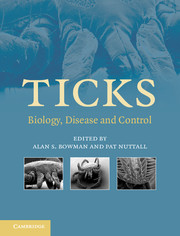Book contents
- Frontmatter
- Contents
- List of contributors
- Preface
- 1 Systematics and evolution of ticks with a list of valid genus and species names
- 2 The impact of tick ecology on pathogen transmission dynamics
- 3 Tick salivary glands: the physiology of tick water balance and their role in pathogen trafficking and transmission
- 4 Tick saliva: from pharmacology and biochemistry to transcriptome analysis and functional genomics
- 5 Tick toxins: perspectives on paralysis and other forms of toxicoses caused by ticks
- 6 Tick lectins and fibrinogen-related proteins
- 7 Endocrinology of tick development and reproduction
- 8 Factors that determine sperm precedence in ticks, spiders and insects: a comparative study
- 9 Tick immunobiology
- 10 Saliva-assisted transmission of tick-borne pathogens
- 11 Lyme borreliosis in Europe and North America
- 12 Viruses transmitted by ticks
- 13 Babesiosis of cattle
- 14 Theileria: life cycle stages associated with the ixodid tick vector
- 15 Characterization of the tick–pathogen–host interface of the tick-borne rickettsia Anaplasma marginale
- 16 Emerging and emergent tick-borne infections
- 17 Analysing and predicting the occurrence of ticks and tick-borne diseases using GIS
- 18 Acaricides for controlling ticks on cattle and the problem of acaricide resistance
- 19 Anti-tick vaccines
- 20 Anti-tick biological control agents: assessment and future perspectives
- 21 Pheromones and other semiochemicals of ticks and their use in tick control
- Index
- References
6 - Tick lectins and fibrinogen-related proteins
Published online by Cambridge University Press: 21 August 2009
- Frontmatter
- Contents
- List of contributors
- Preface
- 1 Systematics and evolution of ticks with a list of valid genus and species names
- 2 The impact of tick ecology on pathogen transmission dynamics
- 3 Tick salivary glands: the physiology of tick water balance and their role in pathogen trafficking and transmission
- 4 Tick saliva: from pharmacology and biochemistry to transcriptome analysis and functional genomics
- 5 Tick toxins: perspectives on paralysis and other forms of toxicoses caused by ticks
- 6 Tick lectins and fibrinogen-related proteins
- 7 Endocrinology of tick development and reproduction
- 8 Factors that determine sperm precedence in ticks, spiders and insects: a comparative study
- 9 Tick immunobiology
- 10 Saliva-assisted transmission of tick-borne pathogens
- 11 Lyme borreliosis in Europe and North America
- 12 Viruses transmitted by ticks
- 13 Babesiosis of cattle
- 14 Theileria: life cycle stages associated with the ixodid tick vector
- 15 Characterization of the tick–pathogen–host interface of the tick-borne rickettsia Anaplasma marginale
- 16 Emerging and emergent tick-borne infections
- 17 Analysing and predicting the occurrence of ticks and tick-borne diseases using GIS
- 18 Acaricides for controlling ticks on cattle and the problem of acaricide resistance
- 19 Anti-tick vaccines
- 20 Anti-tick biological control agents: assessment and future perspectives
- 21 Pheromones and other semiochemicals of ticks and their use in tick control
- Index
- References
Summary
INTRODUCTION
Tissue-specific lectin/haemagglutinin activities have been investigated for both soft and hard ticks, although there are comparatively few papers published. Some tick lectins are proteins with binding affinity for sialic acid, various derivatives of hexosamines and different glycoconjugates. Most tick lectin/haemagglutinin activities are blood-meal enhanced, and could serve as molecular factors of self/non-self recognition in defence reactions against bacteria or fungi, as well as in pathogen/parasite transmission. Dorin M, the plasma lectin of Ornithodoros moubata, is the first tick lectin to be purified from tick haemolymph, and the first that has been fully characterized. Partial characterization of other tick lectins/haemagglutinins has been performed mainly with respect to their carbohydrate-binding specificities and immunochemical features. The main goal of this review is to provide an overview of our knowledge of lectins as tissue specific carbohydrate-binding proteins of ticks with emphasis on their structural properties and functional roles either in defence reactions or pathogen transmission. Other lectin reviews have been published dealing with tissue-specific lectins in blood-sucking arthropods (e.g. Ingram & Molyneux, 1991; Grubhoffer, Hypša & Volf, 1997; Grubhoffer & Jindrák, 1998). In addition, several publications have drawn attention to plant and animal lectins, and to lectins as tools in modern glycobiological research (e.g. Jacobson & Doyle, 1996; Rhodes & Milton, 1998).
Research on lectins began in 1888 with publication of the doctoral thesis of Herman Stilmark at the University of Dorpat, Estonia, on the agglutinins of the seeds of castor bean Ricinus communis (Sharon & Lis, 1988).
- Type
- Chapter
- Information
- TicksBiology, Disease and Control, pp. 127 - 142Publisher: Cambridge University PressPrint publication year: 2008
References
- 2
- Cited by

